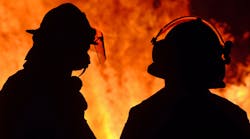The wildfires in California have been particularly devastating this year, including generating massive amounts of smoke that have blanketed many metropolitan areas in the state and which led to reminders from the California Occupational Safety and Health Administration (Cal/OSHA) that its wildfire smoke standard applies to both employees who work inside as well as outside buildings.
“Harmful air quality from wildfire smoke can occur anywhere in the state on short notice, so it is vital that employers prepare early,” stress attorneys Sean Paisan and Sierra Vierra of the Jackson Lewis law firm. With some exceptions, the standard applies to workplaces where the air quality index is 151 (“Unhealthy”) or higher and where it’s reasonably anticipated that employees may be exposed to wildfire smoke.
In addition to applying to outdoor settings, the state safety standard also applies to indoor locations where the air is not filtered or if doors and windows are kept open, such as in warehouses, packing, manufacturing and distribution facilities.
As a result, Paisan and Vierra recommend that employers make sure they are thoroughly familiar with California’s wildfire smoke standard, which was revised and updated by the agency most recently on Sept. 1.
Wildfire smoke and cleanup present hazards that employers and workers in affected regions must understand, Cal/OSHA states, reminding employers that smoke from wildfires contains chemicals, gases and fine particles that can harm health. These hazards continue even after fires have been extinguished and cleanup work has begun. As a result, proper personal protective equipment (PPE) and training are mandated for worker safety in regions impacted by the wildfires.
The agency makes a point of warning employers that smoke is not the only danger workers can face during a wildfire emergency. Power outages can also present electrical and other hazards for workers. Proper installation and use of generators can prevent electrocution hazards.
“Workers must also be aware of the potential of electrocution or being injured by moving parts of machinery and other equipment when power is restored,” according to Cal/OSHA. “Workers also can face health hazards from power outages in unventilated areas when ventilation systems are not working.”
When it comes to the wildfire smoke standard, employers are expected to protect employees from smoke by monitoring the local air quality index; ensuring open communication exists with employees; and modifying the workplace, where possible, to reduce exposure to wildfire smoke.
Tools and Training
Cal/OSHA also requires employers to train their employees on the information contained in Appendix B to Section 5141.1 of the standard. This includes communicating information about the health effects of wildfire smoke. “Although there are many hazardous chemicals in wildfire smoke, the main harmful pollutant for people who are not very close to the fire is ‘particulate matter,’ the tiny particles suspended in the air,” the agency explains.
It adds, “Particulate matter can irritate the lungs and cause persistent coughing, phlegm, wheezing, or difficulty breathing. Particulate matter can also cause more serious problems, such as reduced lung function, bronchitis, worsening of asthma, heart failure and early death.”
In addition, employers must allow employees who show signs of injury or illness due to their exposure to wildfire smoke to seek medical treatment and may not punish affected employees for seeking such treatment. Employers also are expected to have effective provisions made in advance for prompt medical treatment of employees in the event of serious injury or illness caused by wildfire smoke exposure, Cal/OSHA emphasizes.
Employers also are expected to provide proper respiratory protection, like N95 respirators, for voluntary use when work must be performed in a location with poor air quality. Moreover, if the air quality index for particulate matter (PM) 2.5 exceeds 500 because of wildfire smoke, respirator use is mandatory.
Cal/OSHA says employers must make sure employees are using respirators correctly when those situations apply. Respirators also must be certified for protection against the specific air contaminants at the workplace by the National Institute for Occupational Safety and Health (NIOSH). A label or statement of certification should appear on the respirator or respirator packaging that lists what the respirator is designed to protect against, such as particulates.
To assist employers, Cal/OSHA maintains a list of vendors who report available supplies of N95 disposable respirators, which is updated regularly.
If the smoke concentration is too high and employers cannot move operations and do not have access to respiratory protection, then those operations may need to be stopped until the air quality improves, the agency asserts.
The agency says other measures employers are required to take when the current AQI for PM 2.5 is 151 or more include: checking the current AQI at the start of each shift and periodically thereafter; providing additional training to employees; and taking other actions aimed at lowering employee exposures.
It says that exposure can be lowered by locating work in enclosed structures or vehicles where the air is filtered; changing procedures such as moving workers to a place with a lower current AQI for PM2.5; reducing work time in areas with unfiltered air; increasing rest time and frequency; providing a rest area with filtered air; and reducing the physical intensity of the work to help lower the workers’ breathing and heart rates.

